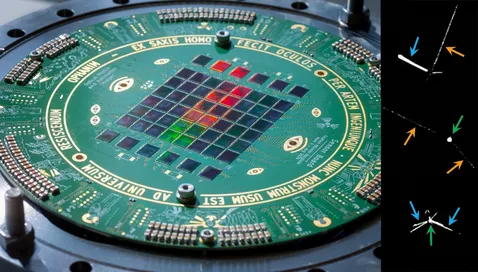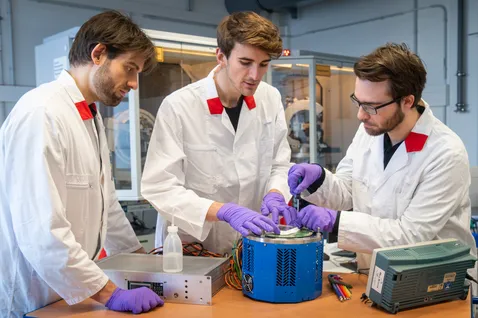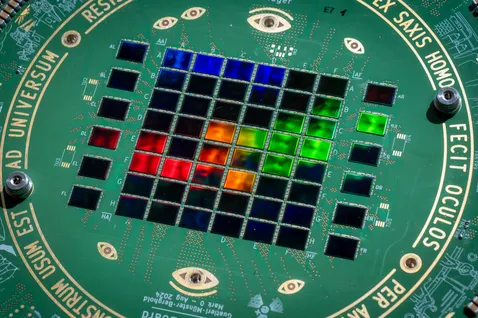Smartphone camera sensor helps with antimatter research at CERN
Aktuell, Wissenschaft, Pressemitteilung |

The AEgIS cooperation (Antihydrogen Experiment: Gravity, Interferometry, Spectroscopy) at CERN is on a mission to measure the free-fall of antihydrogen under Earth’s gravity with high precision. This involves producing a horizontal beam of antihydrogen and measuring its vertical displacement using a device called a moiré deflectometer that reveals tiny deviations in motion and a detector that records the antihydrogen annihilation points.
60 smartphone chips with 3840 MPixels
“For AEgIS to work, we need a detector with incredibly high spatial resolution, and mobile camera sensors have pixels smaller than 1 micrometer,” says Dr. Francesco Guatieri, Principal Investigator of the research, from the group of Prof. Dr. Christoph Hugenschmidt at the research neutron source FRM II at TUM. “We have integrated 60 of them in the single photographic detector, the Optical Photon and Antimatter Imager (OPHANIM), with the highest number of pixels currently operational: 3840 MPixels. Previously, photographic plates were the only option, but they lacked real-time capabilities. Our solution, demonstrated for antiprotons and directly applicable to antihydrogen, combines photographic-plate-level resolution, real-time diagnostics, self-calibration and a good particle collection surface, all in one device.”
Image sensors rebuilt
Specifically, the researchers used Sony optical image sensors that had previously been shown to be capable of imaging low-energy positrons in real time with unprecedented resolution.“ We had to strip away the first layers of the sensors, which are made to deal with the advanced integrated electronics of mobile phones,” says Guatieri. “This required high-level electronic design and micro-engineering.” The two Master’s students Michael Berghold and Markus Münster from the TUM School of Engineering and Design played a key role in this.
“Extraordinary resolution”
“This is a game-changing technology for the observation of the tiny shifts due to gravity in an antihydrogen beam travelling horizontally, and it can also find broader applications in experiments where high position resolution is crucial, or to develop high-resolution trackers.” says AEgIS spokesperson Dr. Ruggero Caravita. “This extraordinary resolution enables us also to distinguish between different annihilation fragments, paving the way for new research on low-energy antiparticle annihilation in materials,” concludes Caravita.
Original text: AEgIS/CERN
Original publication:
M. Berghold et al.
Real-time antiproton annihilation vertexing with sub-micron resolution
Science Advances, 2 April 2025, DOI: 10.1126/sciadv.ads1176
More information:
In addition to researchers from the AEgIS collaboration at CERN and the FRM II at the Technical University of Munich, scientists from the following institutions were also involved in the study:
The German Aerospace Centre (DLR),
University of Trento, TIFPA/ INFN Trento, Italy,
University of Siegen,
University of Latvia,
Technical University in Prague, Czech Republic,
University of West Bohemia, Pilsen, Czech Republic,
University of Oslo, Norway,
INFN Milan, Italy,
University of Innsbruck, Austria,
Nicolaus Copernicus University, Toru’n, Poland
Politecnico di Milano, Italy
Warsaw University of Technology, Poland
Jagiellonian University, Krakow, Poland
Polish Academy of Sciences, Warsaw, Poland
Raman Research Institute, Bangalore, India
University of Leipzig
University of Liverpool, Great Britain
The Cockcroft Institute, Daresbury, Great Britain
INFN Pavia, Italy
University of Brescia, Italy
Contact
Dr. Francesco Guatieri
Forschungs-Neutronenquelle
Heinz Maier-Leibnitz (FRM II)
Technical University of Munich
Email: francesco.guatieri(at)frm2.tum.de
Telefon: +39 324 74 079 38

